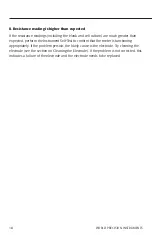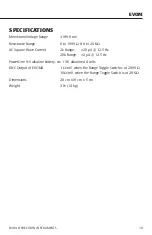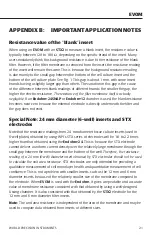
pressed, the meter should display zero or very close to zero. If not, adjust the “Zero
Ω
”
screw with a small flat-head screwdriver until the meter shows a reading of 0.
NOTE:
Do not press either the Test R switch or the Measure R switch while adjusting the
zero. The ZERO
Ω
adjustment affects the meter display only. It does not offset residual
resistance of the fluid or electrode. Therefore, the zero can also be adjusted without the
electrode connected to the meter.
6.
Press the “Measure R” with the electrode still immersed in the electrolyte solution. The
reading should be less than 200
Ω
and stable if the electrode is kept stationary. If it is
not, investigate the following as likely causes:
• Dirty or contaminated electrodes – see Cleaning Procedures
• Culture media or electrolyte solution contamination or concentration error
• Instrument battery failure
TESTING THE ELECTRODE FOR VOLTAGE MEASUREMENTS
1.
Equilibrate the electrode as instructed in the “Electrode Preparation” section under
OPERATING INSTRUCTIONS.
2.
Immerse the electrode tips in an electrolyte solution similar to the experimental
culture medium or in 0.1-0.15 M KCl or NaCl.
3.
Turn the Mode Switch to “V”
4.
Turn the Power on.
5.
The digital panel meter may read 5 or 10 mV due to the asymmetry of the voltage
electrode pair. After 15 minutes, adjust the “Zero V” screw with a flat-head screwdriver
until the meter shows a reading of 0.0 mV. If the electrode asymmetry potential
difference exceeds the zero adjustment range (± 15mV), the central electrodes may be
dirty or contaminated. See the “Cleaning the Electrode” Section under INSTRUMENT
MAINTENANCE.
6.
Voltage drift will only be detected if several measurements are made over a period of
time.
7.
If the meter reads zero, testing is complete. If the meter still does not read zero, see
“Troubleshooting”.
6 WORLD PRECISION INSTRUMENTS











































